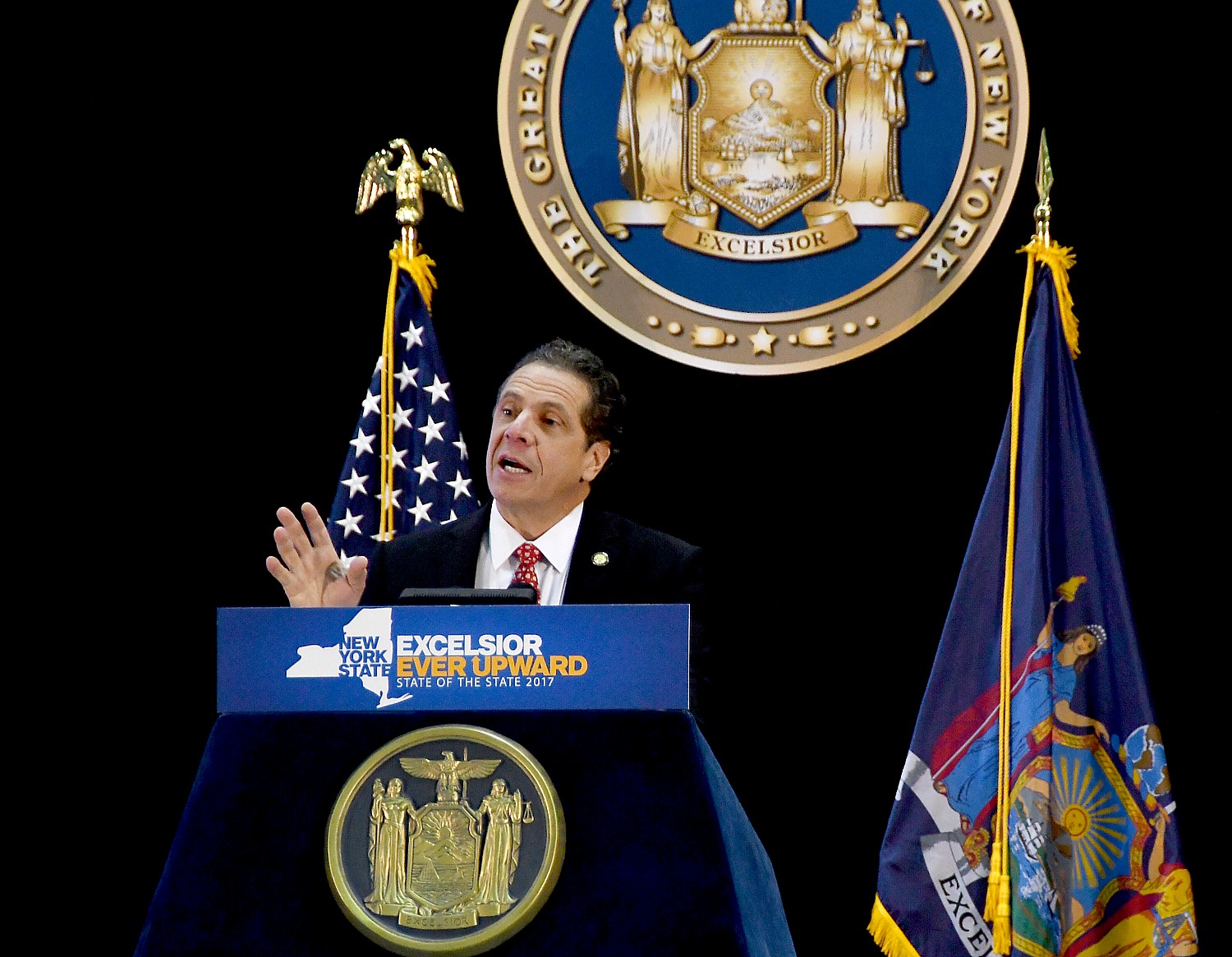
By Karen Rubin, News & Photo Features
There is much to cheer in Governor Cuomo’s State of the State address, one of which he delivered at SUNY Farmingdale on Long Island. His agenda for infrastructure, mass transportation improvements, water quality, affirming women’s reproductive rights, support for immigrants and refugees, free tuition at public colleges for those who qualify, and how he couples the need for aggressive climate action with vigorous sustainable economic development, giving his blessing leading to LIPA’s landmark decision for a 90 megawatt off-shore windfarm to supply the East End, the first utility-scale project in America and making Long Island a leader in a new American industry, put Cuomo in line another New York Governor, Franklin Delano Roosevelt, which FDR brought to the White House as the New Deal (and it is clear Cuomo is jockeying for an eventual run for president).
The one jeer? His renewed assault on local control, which he casts as the culprit for unceasingly high property taxes, which is a not-really-veiled attack on public education.
Each year, Cuomo has used a different mechanism to make the property tax cap – which limits the amount a municipality can raise through property taxes to 2% or the CPI, whichever is less – an offer that can’t be refused. This year, Cuomo has unveiled a “groundbreaking” proposal which mandates the county executive “to develop localized plans that find real, recurring property tax savings by coordinating and eliminating duplicative services and proposing coordinated services to enhance purchasing power, such as jointly purchasing and coordinating use of expensive transportation or emergency equipment. Taxpayers will then vote on these cost-saving plans in a referendum in the November 2017 general election.” If the referendum fails, well then, the plan would need to be reworked and resubmitted in November 2018. (Notably, New York City is exempted.)
But the argument begins with a flawed argument that we spend 2.5 times on property taxes than state income taxes. Doesn’t that spending differential reflect how much we pay for the services we actually receive locally? Plowing snow. Repairing roads. Treating sewage. Picking up garbage. Delivering water. Maintaining police, fire and emergency services. Keeping street lights on. And yes, public education.
Though people like to charge that Long Island pays the highest property taxes in the country, that isn’t true. Nor do New Yorkers pay the highest taxes in the nation, When all taxes are tallied –real estate, income, sales taxes and fees, New York comes in 6th (behind Illinois, Nebraska, Wisconsin, Connecticut and Rhode Island). Nor are the taxes out of line to the incomes earned and home values. But most importantly, for the quality of municipal services including public schools, we want in our community.
Question for Cuomo: before you forcibly consolidate local governments, how much money would be saved by the exercise and how would consolidation actually work? North Hempstead already promotes intermunicipal cooperation; the school districts already participate in joint purchasing and shared services (BOCES) wherever practicable. Indeed, Great Neck public schools now earn a tidy sum in revenue from other districts for tuition paid into programs such as SEAL (rather than paying out $1 million in tuition). If there is waste and duplication, voters can show their ire at the ballot box or make their better-government suggestions known at public meetings.
But the real target of Cuomo’s assault on local governments and property taxes is public education, since 60-65% of the property tax bill goes to fund schools.
Talk about wasteful duplication. If he were so concerned, Cuomo wouldn’t be pushing for a second tier public school system – for-profit charter schools – without the same financial or academic accountability or subject to the same state mandates, to divert money from public schools.
Indeed, Long Islanders wouldn’t pay so much in property taxes if we weren’t so shortchanged in state aid for our public schools – though Long Island has 17% of NY’s student population, we only receive 12% of state aid. It is a lot more obvious when you compare the percentage of school budgets funded by state aid: New York City, where property taxes are low and just about everybody gets some sort of tax holiday, gets 50% of its school budget paid by the state; in comparison less than 5% of Great Neck’s school budget comes from the state. Also, new enterprises, like Avalon Bay residential development, are getting a PILOT by Nassau County’s IDA, reducing the taxes they contribute to the school district as well as Village of Great Neck; the difference is made up by homeowners.
Governor Cuomo has made property taxes, and particularly school taxes, the enemy, falsely claiming that the taxes inhibit growth. But the services that are funded through property taxes contribute to economic growth and activity (an educated workforce, lighted roadways) as well as quality of life.
“Economic theory expects people to consider taxes when deciding where to live, but most studies show taxes only tangentially influence these decisions,” explains Stephanie Hunter McMahon, professor of law at the University of Cincinnati College of Law, in a WalletHub report. “Taxes are, therefore, more influential for what they do or do not provide rather than the rate itself…these taxes are really payments for the goods and services state and local governments provide to the taxpayer and other members of the community.”
______________________________
© 2017 News & Photo Features Syndicate, a division of Workstyles, Inc. All rights reserved. For editorial feature and photo information, go to www.news-photos-features.com, email editor@news-photos-features.com. Blogging at www.dailykos.com/blogs/NewsPhotosFeatures. ‘Like’ us on facebook.com/NewsPhotoFeatures, Tweet @KarenBRubin
